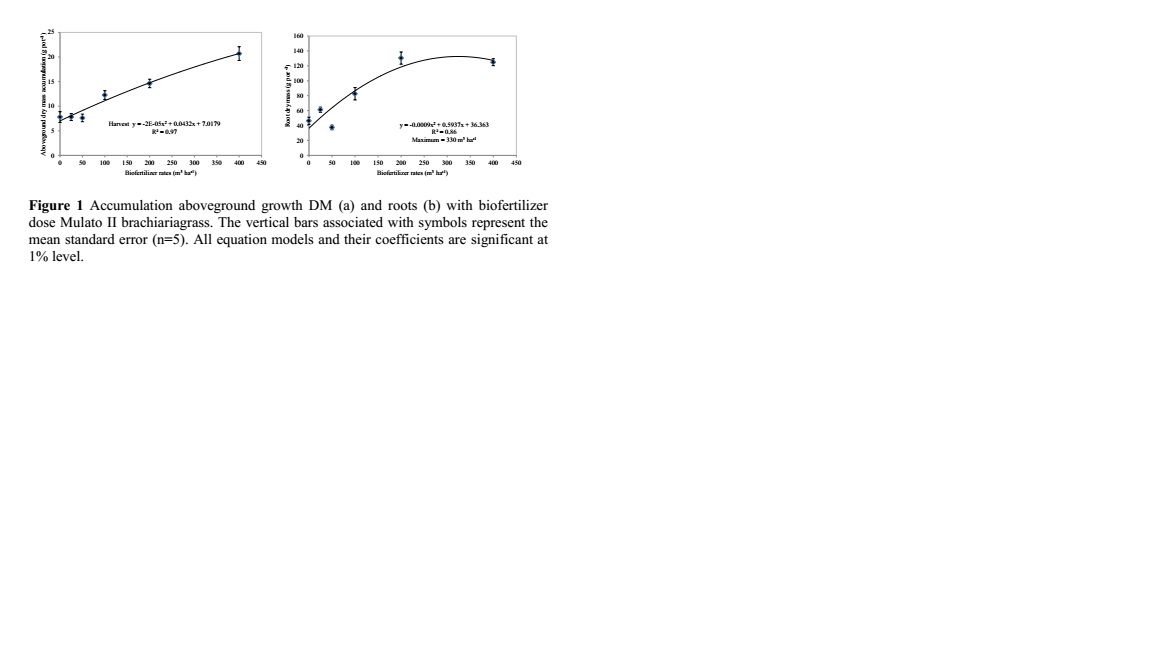
Efeitos da aplicação de biofertilizantes orgânicos de esterco de gado leiteiro sobre produção de massa seca e raízes de Brachiaria sp. cv Mulato II
2 - UNESP-FMVA
3 - UNESP-FMVA
4 - UNESP-FMVA
5 - UNESP-FMVA
6 - UNESP-FMVA
7 - UNESP-FMVA
RESUMO -
O manejo da adubação nitrogenada em pastagem tem grande importância para a produção e manutenção da pecuária brasileira. Com o objetivo de avaliar a produção de massa seca da parte áerea e raízes da Brachiaria hybrida cv. Mulato II submetida a doses de biofertilizante orgânico como fonte de nitrogênio, realizou-se um experimento em casa de vegetação, de outubro de 2014 a março de 2015. Os tratamentos foram dispostos em delineamento inteiramente casualizado, adubado com seis doses de biofertilizante orgânico (0; 25; 50; 100; 200 e 400 m3/ha) e cinco repetições durante quatro ciclos de crescimentos (cortes). Com a aplicação de doses de biofertilizante orgânico verificou-se resposta quadrática na produção acumulada de massa seca da parte aérea até a dose de 400 m3 ha-1 e massa seca de raízes até a dose de 330 m3 ha-1 de biofertilizante orgânico.
Effects of the application of organic biofertilizer of manure of dairy cattle on dry mass production and roots of Mulato II Brachiariagrass
ABSTRACT - The management of nitrogen fertilization in pasture has great importance for the production and maintenance of Brazilian livestock. The objective of this study was to evaluate dry mass production of the aerial part and roots, of the Mulato II brachiariagrass that received doses of organic biofertilizer as a nitrogen source. A greenhouse experiment was carried out from October 2014 to March 2015. The treatments were arranged in completely randomized blocks, were fertilized with six doses of organic biofertilizer (0, 25, 50, 100, 200 and 400 m3 ha-1) and had five replicates during four harvest cycles. With the application of organic biofertilizer doses, there was a quadratic response in the accumulated dry mass production of the aerial part for up to a dose of 400 m3 ha-1 of organic biofertilizer and dry mass production of the roots for up to a dose of 330 m3 ha-1 of organic biofertilizer.Introdução
The production of ruminants in pasture is undoubtedly one of the most efficient forms of animal feed. However, maintaining the compatibility of forage productivity with soil and climatic conditions in order to keep the system sustainable over time is one of the major problems in livestock farming, because of the degradation of these ecosystems. In this sense, the search for a solution to this problem involves not only the identification of suitable forage materials for different conditions, but also the optimal levels of fertilization that guarantee perennial production. Because grassland species can respond differently to fertilizer application, it was hypothesized that the response of grassland species to animal manure would also vary. This was tested by assessing the responses of brachiariagrass to different doses of dairy cattle biofertilizer. The objective of this work was to evaluate dry mass production of shoot and roots of Mulato II brachiariagrass submitted to doses of organic biofertilizer as the N source.Revisão Bibliográfica
Due to the high nitrogen (N) requirement for crops and the current need for this nutrient to be used organically, alternative sources of N, that is, organic biofertilizers, such as cattle manure, for pasture fertilization are being used and studied to reduce environmental pollution, as well as to reduce production costs, building on sustainable management. Furthermore, the resolution CONAMA n.237 / 1997 requires that the nutrients in all animal manures are taken into account in farm nutrient management plans. Mulato II brachiariagrass (commercialized in Brazil as Convert HD 364 since 2009) was developed from three generations of hybridization between ruzigrass (clone 44-6) and signalgrass (B. decumbens (Stapf) R. D. Webster (syn. U. decumbens (Stapf) R. D. Webster) (cultivar Basilisk), where the first generation was exposed to open pollination from lines of B. brizantha, including Marandu palisadegrass (Argel et al., 2007). The Mulato II brachiariagrass is characterized by a number of leaves ranging from nine to ten per tiller with a high tillering potential, which contributes to good soil cover (Argel et al., 2007). This grass has a high potential for forage production, depending mainly on the soil characteristics in which it will be planted. The use or lack of fertilization, whether with nitrogen or other sources, will also influence the productivity of the grass. It is a grass that easily adapts to tropical conditions and tolerates soils with drainage deficiencies, if the flooding is not permanent but requires medium to high fertility soils with good. On the other hand, the maintenance and productivity of forage plants can be maximized by increasing the use of fertilizers. In this sense, fertilization, especially with nitrogen, is fundamental for the increase of biomass production. The increase in the N content in the soil through fertilization is one way to increase productivity in pastures, especially when the forage responds to the application of this nutrient (Martuscello et al., 2005). However, the efficient use of N by the plant depends on several factors, among them, source, form and time of application, dose and fractionation of N, soil and climatic conditions, the potential response of the plant, and the presence and dose of animal stocking, among others. Bovine biofertilizer from anaerobic biodigestors contains N in greater quantities. Soares Filho et al. (2015) applied bovine biofertilizer to Tierra Verde bermudagrass (Cynodon dactylon) and Lemes et al. (2013) to alfalfa (Medicago sativa), and the authors observed that it positively influenced the soil and leaf chemical contents and the nutritional quality of alfalfa (Lemes et al., 2016). In Brazil, there is a considerable part of cattle production conducted in intensive rearing systems, resulting in a large volume of liquid slurry, with high fertilizer potential that, when properly stored and correctly used, can supply nutrients to the plants and improve soil chemical conditions.Materiais e Métodos
One experiment was conducted during the spring and summer in a greenhouse (average temperature of 26.4 °C and photoperiod of 14/10 h, day / night), cultivating the forage Mulato II brachiariagrass, at São Paulo State University, (UNESP-FMVA) in Araçatuba, state of São Paulo, Brazil (21°8' S, 50°25' W, 415 m a.s.l.). Brachiariagrass seeds were germinated in plastic pots. The organic biofertilizer used in the experiment comes from manure and cow urine from dairy cows after being fermented anaerobically in a biodigester. The effluent presented the following characteristics: organic matter (OM): 32.90 g/L; total N 0.97 g/L; phosphorus (P) in P2O5: 1.27 g/L; potassium (K) in K2O: 0.68 g/L; sulfur (S): 0.09 g/L; calcium (Ca): 1.27 g/L; magnesium (Mg): 0.35 g/L; copper (Cu): 1325 mg/L; manganese (Mn): 1215 mg/L; zinc (Zn): 1663 mg/L; iron (Fe): 8382 mg/L; density: 1010 g/ml; and pH 7.50. For each experimental unit, 5 dm3 of soil classified as Ultisol. The experimental design was completely randomized, with five replications, arranged in subdivided plots, with repeated measures in time (four growth cycles). In the main plots were different doses of organic biofertilizer (0, 25, 50, 100, 200 and 400 m3 ha-1). Two weeks after the emergence of Mulato II brachiariagrass, thinning was performed to keep five uniform plants per pot. The grass was evaluated when it reached an average height of 35 cm, and the harvest was done to 15 cm of the surface of the ground. Four growth cycles with a 6-week interval were evaluated. The roots were collected at the end of the experiment and washed in running water until all existing soil was removed, using 2-mm mesh sieves. The statistical analysis was carried out with Assistat version 7.7 beta statistical software (Silva, 2015). An analysis of variance was performed. When F-tests revealed significant differences between biofertilizer doses, linear and quadratic regressions were carried out.Resultados e Discussão
The accumulated dry mass production of the herbage mass of Mulato II brachariagrass presented significant result from the analysis of variance for the organic biofertilizer doses (P <0.001) (Figure 1a). The biofertilizer doses positively affected the accumulated dry mass production of the forage, with a quadratic effect of up to 400 m3 ha-1. In a study that evaluated doses of N and K in Xaraés palisadegrass, Rodrigues et al. (2006) found that increases in N and K doses positively influenced dry mass production of the aerial part of this grass. These authors reported that, in order to obtain greater production of this grass, it is indispensable to use higher doses of N and K. Similar results were obtained by Lavres Jr. & Monteiro (2003) who, working with Panicum maximum cv. Mombaça (guinea grass) under doses of N and K, observed similar behavior. The importance of N and K fertilization for the main production factors such as dry mass in tropical grasses were also reported by Rodrigues et al. (2006). Results similar to these were found by Schimidt et al. (2003), when studying the effects of N doses (0, 60, 120 and 180 kg ha-1) as a biofertilizer in Panicum maximum cv. Tanzania (guinea grass), they observed that the dry weight of the aerial part was higher in the fertilized vessels with the highest doses of biofertilizer in the third harvest occurring at 84 days after planting. Lemes et al. (2013) working with increasing doses of bovine biofertilizer observed a linear increase in shoot dry mass production and alfalfa roots. The supply of organic biofertilizer resulted in significant changes in the root growth performance. For the dry mass production of the roots after the harvest at the end of the experiment, there was a significant effect from the biofertilizer doses (P <0.001) (Figure 1b). From the analysis of variance, the quadratic effect of the nitrogen fertilization on dry mass of the roots was verified, and the maximum yield was obtained with the biofertilizer dose of 330 m3 ha-1. Mulato II brachiariagrass, belowground and total dry mass production were positively correlated (P <0.001) with a shoot / root dry mass of 0.78, a shoot / total dry mass of 0.83 and a root / total dry mass of 0.99. The literature suggests that plants in N deficient soils tend to increase their root mass as a way to explore a higher soil volume. Schimidt et al. (2003), in addition to the abovementioned dry mass production of the aerial part, found the highest dry mass production of the roots at the highest studied dose (180 kg ha-1) of biofertilizer. An increase in root dry mass production of 69% for the dose at the maximum point (from that peak) of organic biofertilizer of 330 m3 ha-1 was observed in relation to the control. Excess biofertilizer available at the highest dose yielded average growth (lower dry mass production), possibly because organic N reserves may have stimulated plants to reduce the energy investments required to expand the root system.Conclusões
With the application of organic biofertilizer doses, there was a quadratic response in the accumulated dry mass production of the aerial part for up to a dose of 400 m3 ha-1 of organic biofertilizer and dry mass production of the roots for up to a dose of 330 m3 ha-1 of organic biofertilizer.Gráficos e Tabelas



